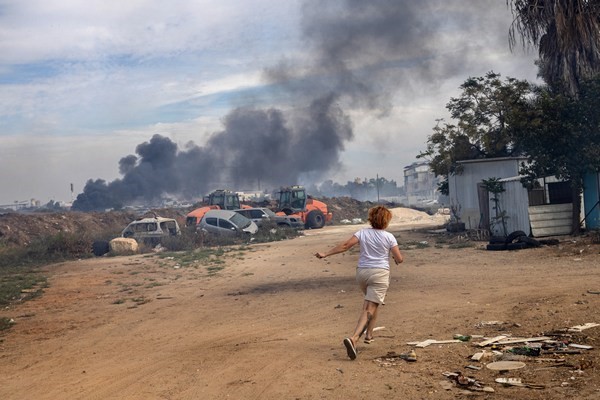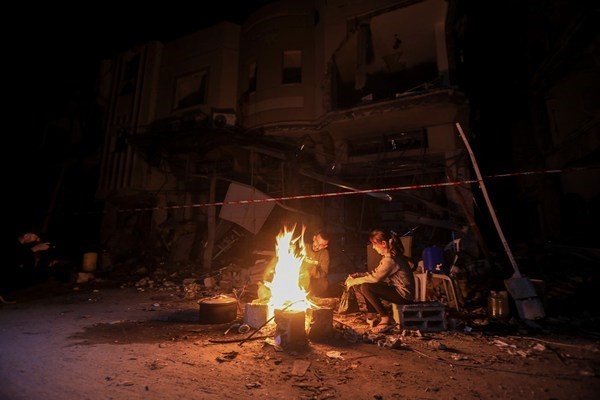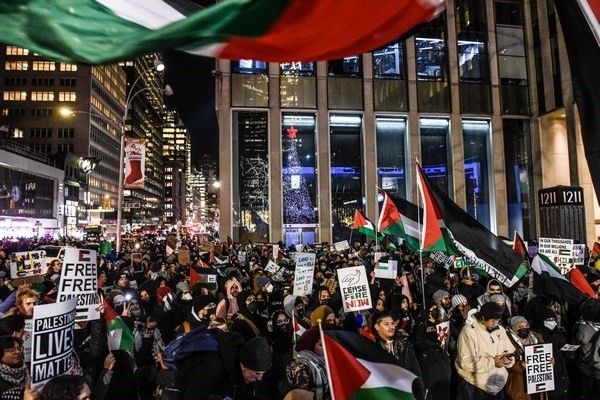TEL AVIV – According to Israeli officials,
they had obtained plans for October 7, more than a year before it happened.
This included documents, emails, and interviews. However, occupation forces and
intelligence officials dismissed the plan as aspirational, considering it too
difficult for the Al-Qassam Brigades, the Hamas military wing to carry out.
اضافة اعلان
According to the New York Times, the
approximately 40-page document, which Israeli authorities code-named “Jericho
Wall,” outlined, point by point, exactly the kind of devastating invasion that
led to the deaths of about 1,200 people.
The translated document, which was reviewed
by the Times, did not set a date but described a methodical assault designed to
overwhelm the fortifications around the Gaza Strip, take over Israeli cities,
and storm key military bases, including a division headquarters.
Al-Qassam followed the blueprint with
shocking precision. The document called for a barrage of rockets at the outset
of the attack, drones to knock out the security cameras and automated machine
guns along the border, and gunmen to pour into Israel en masse in paragliders,
on motorcycles, and on foot — all of which happened on October 7, also known as
the “Al-Aqsa Flood Operation.”
The plan also included details about the
location and size of Israeli occupation forces, communication hubs, and other sensitive
information, raising questions about how Al-Qassam gathered its intelligence
and whether there were leaks inside the Israeli security establishment.
The document circulated widely among
occupation forces and intelligence leaders, but experts determined that an
operation of that scale and ambition was beyond Hamas’ capabilities, according
to documents and officials. It is unclear whether Israeli Prime Minister
Benjamin Netanyahu or other top political leaders saw the document, as well.
 Evgenia Simanovich runs to the family home’s reinforced concrete shelter, moments after rocket sirens sounded in Ashkelon, Israel on Saturday, Oct. 7, 2023. Israeli officials obtained Hamas’s battle plan for the Oct. 7 attack more than a year before it happened, documents and emails show. But military and intelligence officials dismissed the plan as aspirational, considering it too difficult for Hamas to carry out.
Evgenia Simanovich runs to the family home’s reinforced concrete shelter, moments after rocket sirens sounded in Ashkelon, Israel on Saturday, Oct. 7, 2023. Israeli officials obtained Hamas’s battle plan for the Oct. 7 attack more than a year before it happened, documents and emails show. But military and intelligence officials dismissed the plan as aspirational, considering it too difficult for Hamas to carry out.
Last year, shortly after the document was
obtained, officials in the occupation forces Gaza division, which is
responsible for defending the border with Gaza, said Al-Qassam Brigades’
intentions were unclear.
“It is not yet possible to determine
whether the plan has been fully accepted and how it will be manifested,” read a
military assessment reviewed by the Times.
Then, in July, just three months before
October 7, a veteran analyst with Unit 8200, Israel’s signals intelligence
agency, warned that Al-Qassam Brigades had conducted an intense, daylong
training exercise that appeared similar to what was outlined in the blueprint.
 Palestinians cut down trees in cemeteries to get some firewood to use for lighting fires and cooking in the center of Khan Younis, in the southern Gaza Strip, on Wednesday, Nov. 29, 2023.
Palestinians cut down trees in cemeteries to get some firewood to use for lighting fires and cooking in the center of Khan Younis, in the southern Gaza Strip, on Wednesday, Nov. 29, 2023.
But a colonel in the Gaza division brushed
off her concerns, according to encrypted emails viewed by the Times.
“I utterly refute that the scenario is
imaginary,” the analyst wrote in the email exchanges. The Hamas training
exercise, she said, fully matched “the content of Jericho Wall.”
“It is a plan designed to start a war,” she
added. “It is not just a raid on a village.”
Officials privately concede that had the
military taken these warnings seriously and redirected significant
reinforcements to the south, Israel could have blunted the attacks or possibly
even prevented them.
 People gather around a fire at dusk amid homes destroyed by Israeli airstrikes in Khan Younis, in the southern Gaza Strip, on Wednesday, Nov. 29, 2023.
People gather around a fire at dusk amid homes destroyed by Israeli airstrikes in Khan Younis, in the southern Gaza Strip, on Wednesday, Nov. 29, 2023.
Instead, occupation forces were unprepared
as fighters streamed out of the Gaza Strip.
Israeli security officials have already
acknowledged that they failed to protect the country, and the government is
expected to assemble a commission to study the events leading up to October 7.
The Jericho Wall document lays bare a yearslong cascade of missteps that
culminated in what officials now regard as the worst Israeli intelligence
failure since the Arab-Israeli war of 1973.
 Pro-Palestinian demonstrators protest outside the News Corp. building in New York during the Rockefeller Christmas Tree lighting ceremony on Wednesday, Nov. 29, 2023. Talks were underway to extend a cease-fire slated to expire in Gaza on Thursday morning, which has seen a daily exchange of prisoners for hostages.
Pro-Palestinian demonstrators protest outside the News Corp. building in New York during the Rockefeller Christmas Tree lighting ceremony on Wednesday, Nov. 29, 2023. Talks were underway to extend a cease-fire slated to expire in Gaza on Thursday morning, which has seen a daily exchange of prisoners for hostages.
Underpinning all these failures was a
single, fatally inaccurate belief that Al-Qassam Brigades could not attack and
would not dare to do so. That belief was so ingrained in the Israeli
government, officials said, that they disregarded growing evidence to the
contrary.
Officials would not say how they obtained
the Jericho Wall document, but it was among several versions of plans collected
over the years. A 2016 Defense Ministry memorandum viewed by the Times, for
example, says, “Al-Qassam Brigades intends to move the next confrontation into
Israeli territory.”
The Jericho Wall document, named for the
ancient fortifications in the modern-day West Bank, was even more explicit. It
detailed rocket strikes to distract Israeli soldiers and send them hurrying
into bunkers, and drones to disable the elaborate security measures along the
border fence separating Israel and Gaza.
 Police detain a pro-Palestinian demonstrator participating in protests outside the News Corp. building in New York, during the Rockefeller Christmas Tree lighting ceremony on Wednesday, Nov. 29, 2023. Talks were underway to extend a cease-fire slated to expire in Gaza on Thursday morning, which has seen a daily exchange of prisoners for hostages.
Police detain a pro-Palestinian demonstrator participating in protests outside the News Corp. building in New York, during the Rockefeller Christmas Tree lighting ceremony on Wednesday, Nov. 29, 2023. Talks were underway to extend a cease-fire slated to expire in Gaza on Thursday morning, which has seen a daily exchange of prisoners for hostages.
Al-Qassam resistance fighters would then
break through 60 points in the wall, storming across the border into Israel.
One of the most important objectives outlined
in the document was to overrun the Israeli military base in Re’im, which is
home to the Gaza division responsible for protecting the region. Other bases
that fell under the division’s command were also listed.
Al-Qassam Brigades carried out that
objective on October 7 as it made its way through Re’im and overran parts of
its base.
The audacity of the blueprint, officials
said, made it easy to underestimate. All militaries write plans that they never
use, and Israeli officials assessed that, even if Al-Qassam Brigades invaded,
it might muster a force of a few dozen, not the hundreds.
 Wood is gathered from trees cut down in cemeteries for firewood to use for lighting fires and cooking in the center of Khan Younis, in the southern Gaza Strip.
Wood is gathered from trees cut down in cemeteries for firewood to use for lighting fires and cooking in the center of Khan Younis, in the southern Gaza Strip.
Israel had also misread Al-Qassam Brigades’
actions. The group had negotiated for permits to allow Palestinians to work in
Israel, which Israeli officials took as a sign that Al-Qassam Brigades was not
looking for a war.
But Al-Qassam Brigades had been drafting
plans for many years, and Israeli officials had gotten hold of previous
iterations of them. What could have been an intelligence coup turned into one
of the worst miscalculations in Israel’s 75-year history.
Read more Region and World
Jordan News



